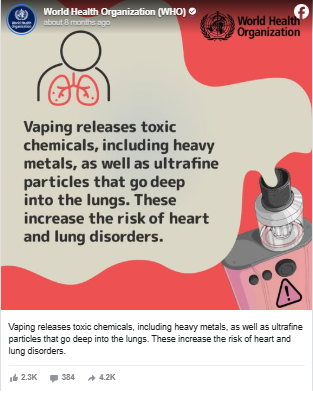Doctor Says Eligible Young Adults Should Think Twice About Nicotine-Free Vaping
So, you’ve traded in your cigarettes for a vape, convinced that it’s a far healthier alternative. No smoke. No tar. No nicotine, even. But according to new research, that assumption may be dangerously misleading. A 2024 medical study has revealed that nicotine-free vaping can still harm your vascular system, potentially increasing the risk of heart disease, poor circulation, and long-term damage to blood vessels. In other words, just because your vape doesn’t contain nicotine doesn’t mean it’s harmless.
From Smoking to Vaping: A False Sense of Safety? Traditional cigarettes are notorious for containing thousands of harmful substances — including tar, carcinogens, and carbon monoxide. In contrast, e-cigarettes (also called vapes) don’t burn tobacco and often advertise themselves as “cleaner” or “safer.”
However, scientists now say that even nicotine-free vapes expose users to chemical compounds that can harm respiratory and cardiovascular health. That means if you’ve never smoked before and believe you’re safe because your vape is nicotine-free, you may still be putting your health at unnecessary risk. And what’s more troubling? Many of those affected are young, otherwise healthy, and eligible by age to purchase vape products in their state or country. But legal eligibility doesn’t equal medical safety.
Buy vitamins and supplements
What Exactly Is Vaping
E-cigarettes are battery-powered devices that heat up a liquid (often called e-liquid or vape juice) to create an aerosol — not smoke, but a vapor — that users inhale. Because vapes don’t combust tobacco or emit the same visible pollutants as cigarettes, they’re often seen as the “healthier” choice. But the key word here is “perceived.” As it turns out, the aerosol isn’t just flavored steam — it contains ultrafine particles, chemicals, and metals that can damage lung tissue and affect heart function.
The Juice: What’s Actually Inside Vape Liquid?
E-liquids typically contain a base mixture of propylene glycol (PG) and vegetable glycerin (VG). These ingredients are FDA-approved for oral consumption, but inhaling them is an entirely different story. When heated and inhaled, PG and VG can break down into toxic byproducts such as formaldehyde and acrolein, both of which are known respiratory irritants. Long-term exposure may contribute to:
- Chronic coughing
- Shortness of breath
- Lung inflammation
- Airway irritation
Flavors: Fun on the Surface, Dangerous Inside
The real appeal of vaping for many — especially youth — is the vast range of sweet, minty, or fruity flavors. But these flavorings often contain volatile organic compounds (VOCs) and other additives that can be hazardous when inhaled. Some harmful substances found in flavored vapes include:
- Diacetyl – linked to bronchiolitis obliterans, a condition nicknamed “popcorn lung”
- Benzaldehyde – commonly used in cherry flavors and a known respiratory irritant
- Heavy metals – including nickel, lead, and tin, released from the heating coils in some vape devices
Even nicotine-free flavored e-liquids can contain these compounds, and repeated exposure can lead to lung inflammation, airway damage, and reduced immune response in the lungs. Dr. Michael Blaha from Johns Hopkins Medicine warns: “You’re exposing yourself to all kinds of chemicals that we don’t yet understand and that are probably not safe.”
The Rise of Vaping Among Youth
According to Johns Hopkins, over 2 million middle and high school students in the U.S. used e-cigarettes in 2021, and more than 80% reported using flavored versions. That means millions of young people, legally eligible to purchase or access vape devices, are regularly inhaling substances that may pose long-term health risks.
Buy vitamins and supplements
Dr. Blaha expressed deep concern, especially for first-time users: “It’s one thing if you convert from cigarette smoking to vaping. It’s quite another to start up nicotine use with vaping. And getting hooked on nicotine often leads to using traditional tobacco products down the road.” But even among nicotine-free users, health concerns remain.
The Study That Changed Everything
Researchers set out to determine whether the base chemicals and flavor additives used in nicotine-free e-cigarettes could have immediate physiological effects — even without nicotine present. To test this, they compared the impact of:
- Nicotine-free vapes
- Nicotine-containing vapes
- Traditional cigarettesBuy vitamins and supplements
The results were eye-opening. All three had measurable negative effects on vascular function — the ability of blood vessels to expand and contract properly. Although vapes with nicotine showed the most significant decrease, nicotine-free vapes still demonstrated a clear and concerning drop in vascular performance.

Dr. Marianna Nabbout, the study’s lead researcher, emphasized the findings: “This study serves to highlight the acute effects smoking and vaping can have on multiple vascular beds in the human body.” More importantly, she added: “If the acute consumption of an e-cigarette can have an effect that is immediately manifested at the level of the vessels, it is conceivable that chronic use can cause vascular disease.” In plain terms: If your blood vessels react poorly to just one vape session, imagine the damage months or years of regular use could cause.
So… Is Vaping Really Safer?
While vaping may reduce exposure to some of the toxic substances found in cigarettes, the idea that nicotine-free vaping is safe is increasingly being challenged by science. And for individuals who are young, healthy, or never smoked before, the risks may outweigh any perceived benefits. Legal age or not, being eligible to buy vape products doesn’t mean you’re protected from harm.
Buy vitamins and supplements
Final Thoughts: What Should You Do?
If you’ve started vaping because you thought it was a harmless alternative — or because you were attracted to the flavors — this research is a critical wake-up call. You might be eligible to vape. You might be old enough to decide for yourself. But that doesn’t make it safe.
Your Turn
What are your thoughts on nicotine-free vaping? Do you think the risks are being underestimated by the public — especially youth? Let us know your opinion in the comments. And please share this story to help raise awareness. The more we understand about these hidden health risks, the more we can protect our communities — and make informed, truly healthy choices.
